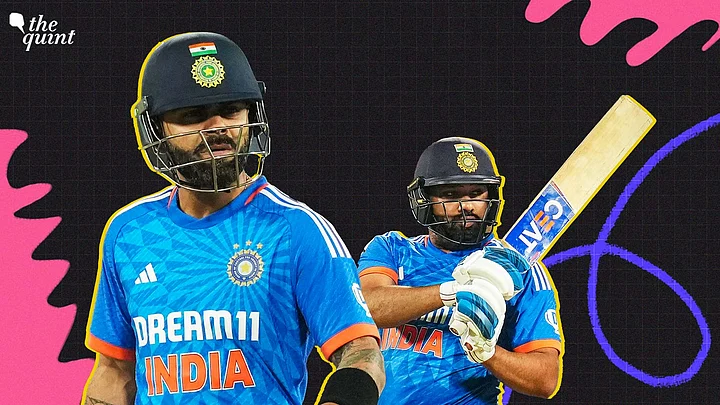That, India recorded a 3-0 clean sweep in the recently concluded T20I series against Afghanistan, might only be a peripheral postscript from the eclectic perspective of the Indian team management. With this being the last T20I series before June’s T20 World Cup, the think tank was searching for – beyond merely the three victories – answers to crucial questions.
Some of the questions were diligently answered, whilst others still remain an enigma. So, let us take a look at what we learned from this series:
Rohit Sharma Belongs Here, and So Does Virat Kohli
“Will you drop Rohit Sharma from T20? Will you drop Rohit Sharma? Unbelievable,” said Virat Kohli on 24 October 2021, only a few minutes after India succumbed to an unceremonious 10-wicket defeat against Pakistan. His words were laced with sarcasm, which screamed out loud – Rohit Sharma is not going anywhere.
Two years and three months later, Rohit has proven yet again why he belongs in the Indian T20 scheme of things, and so does Virat Kohli.
Rohit’s return to the game’s shortest format, after fourteen months, was not jim-dandy. A run out, and then a Fazalhaq Farooqi peach prevented him from recording anything north of zero in the first couple of matches. But then, on the third match, Bengaluru – the purported den of Virat Kohli – saw the brilliance of Rohit. He first scored a 69-ball 121, but when it proved to be inadequate, he came to the team’s rescue by scoring a four-ball 14 and a three-ball 11 in two Super Overs.
Virat Kohli’s series accumulation – 29 runs – might not be a tenable reason to claim his place in the team has been cemented, but circumstantial factors outweigh the crude statistics.
Missing the first match owing to personal reasons, the former skipper offered a glimpse of his new T20I mould – one that is in synchronization with India’s nascent fearless approach – in the second match. Despite India losing their skipper in only the first over, he took the attack to the Afghan bowlers by playing a lofted shot over mid-off in only the second delivery he faced, before playing a slog-sweep – a shot one does not associate Virat Kohli with – in that same over. That, he was dismissed for a duck in the last game, can be deemed to be a rare blip.
Yashasvi Jaiswal Climbs up the Pecking Order, Shubman Gill Demoted
With Rohit and Kohli occupying two of the top three slots in the Indian batting order, this series presented a contest between Shubman Gill and Yashasvi Jaiswal for the only other available slot. With the latter nursing an injury, the former was handed an opportunity in the first match, but with only 23 runs, alongside a miscommunication which resulted in the skipper’s wicket, he could not capitalise on it.
A fit-again Jaiswal featured in the second match, and played a knock which has effectively propelled him a place above Gill in the pecking order. Chasing a target of 173 in Indore, the 22-year-old scored a 34-ball 68, comprising five fours and six maximums.
The Shivam Dube Delight
Till a week ago, Hardik Pandya’s recurring injuries could have been considered as among India’s potential vulnerabilities, going into the T20 World Cup. Now, that concern has a perfectly effective two-word solution – Shivam Dube.
After being a mere spectator of India’s last home T20I series, against Australia, Dube brandished the bat and rolled his arm over for the first time since October 2023’s Asian Games.
And bat he did, scoring 124 runs at a strike rate of 158.97, making him the leading run-scorer of the series. An unbeaten 40-ball 60 was followed by a 32-ball in Indore, with both knocks coming whilst chasing.
Besides that, he also scalped a couple of wickets – that of Afghanistan skipper Ibrahim Zadran in the first game, and an in-form Azmatullah Omarzai in the second game.
Where Does Rinku Singh Go From Here?
If your answer to the aforementioned question is the United States of America and West Indies, for the T20 World Cup, you are not in the wrong. For, having scored 94 runs at a strike rate of 164.91, Rinku Singh’s place in the Indian T20 squad is all but cemented.
Albeit, the same cannot be said about his place in the starting XI, with the Indian management staring at a problem of plenty. With the Rohit-Jaiswal-Kohli trio forming the top three, followed by Suryakumar Yadav – the number one T20I batter in the world – and wicketkeeper-batter Jitesh Sharma, only one slot is available in the Indian batting order.
Hardik Pandya will have his claim over that spot once he recuperates from his injury, which effectively leaves no space for Rinku Singh. But for a batter who has a repertoire of match-winning knocks in his short career, the latest of them being a 39-ball 69 in Bengaluru, can coach Rahul Dravid and his managerial compatriots make room?
Ravi Bishnoi Might Be India’s Prime T20I Spinner
Barring the opening slot, this series also promised to solve the dilemma regarding India’s prime T20I spinner, which it did to an extent, with Ravi Bishnoi edging past Kuldeep Yadav.
Though only two wickets in three matches, and an economy rate of 10.18 runs per over do very little to inspire confidence, Bishnoi was entrusted with the responsibility of bowling the more difficult overs – in the powerplay, and also the second Super Over of the last T20I.
He excelled in both – dismissing Rahmanullah Gurbaz when Afghanistan had a decent start in Indore, and then conceding only two runs in the match-winning over in Bengaluru.
Kuldeep Yadav, on the contrary, was given only one opportunity, where he did pick up a wicket, but also conceded 31 runs in three overs.
(At The Quint, we question everything. Play an active role in shaping our journalism by becoming a member today.)
